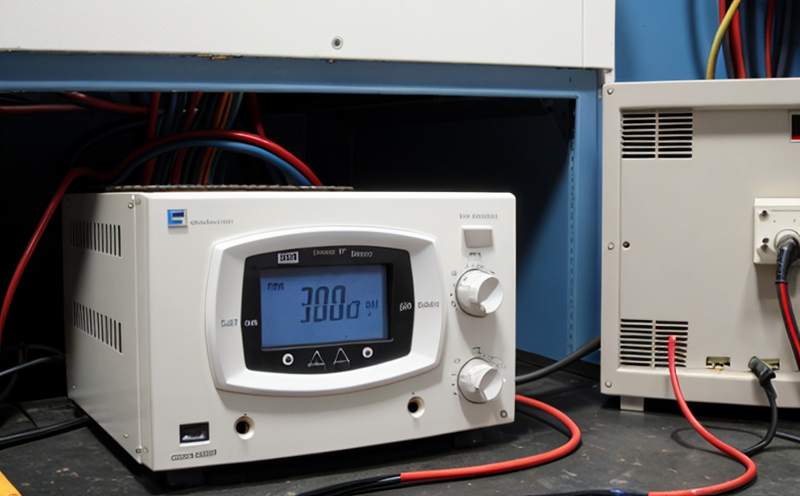EN 55015 EMC Emission Testing of Lighting Equipment
The European standard EN 55015, formally known as “Electromagnetic compatibility (EMC) – Limits for radio disturbance characteristics in the frequency range from 150 kHz to 30 MHz,” is a crucial specification that defines limits on electromagnetic emissions for lighting equipment. This standard ensures that electronic devices and systems do not interfere with other nearby electrical appliances, especially in environments where sensitive electronics are present.
EN 55015 testing is particularly important for manufacturers of LED lights, fluorescent lamps, CFLs (compact fluorescent lamps), and any other form of lighting equipment. The standard aims to prevent electromagnetic interference that can cause malfunctions or failures in other electronic devices. Compliance with this standard helps protect both the environment and users by ensuring that the emitted noise does not exceed acceptable levels.
The testing process involves placing the specimen under scrutiny within a Faraday cage, which simulates real-world conditions where the equipment might be used. The device is then subjected to various frequency bands (from 150 kHz to 30 MHz) to assess its performance and ensure it meets all specified limits. If any emissions exceed these thresholds, adjustments must be made until compliance is achieved.
Compliance with EN 55015 is mandatory for products intended for sale within the European Union market. Failure to meet this requirement can result in product recalls or even bans from being sold on EU markets. Additionally, manufacturers may face penalties under relevant national and regional regulations.
To facilitate easier understanding of how our testing aligns with EN 55015 requirements, we provide detailed reports that summarize findings alongside recommended actions for improvement if necessary. Our team uses state-of-the-art equipment calibrated according to international standards such as ISO/IEC 17025:2017 and IEC 61326-1.
Our experts offer comprehensive support throughout the entire process, from initial consultation through final report generation. They will guide you on best practices for preparing your samples before testing begins. This includes ensuring proper labeling, documentation, and packaging to maintain integrity during transport to our facility.
The testing procedure typically follows these steps:
- Identification of the type of lighting equipment being tested
- Setup of the test setup including placement of the specimen inside a Faraday cage
- Application of various frequency bands starting from 150 kHz up to 30 MHz
- Measurement and recording of all relevant parameters
- Evaluation against EN 55015 limits
- Issuing of certification or corrective action recommendations based on evaluation results
Our rigorous approach ensures accurate measurement and reliable results. By adhering strictly to industry standards, our laboratory provides trustworthy data that can be used confidently by manufacturers when marketing their products.
| Parameter | Description |
|---|---|
| Frequency Range | 150 kHz - 30 MHz |
| Emission Levels | As per EN 55015 limits |
| Testing Methodology | Faraday Cage Setup |
| Data Reporting | Detailed Compliance Reports |
Industry Applications
The application of EN 55015 testing extends beyond mere compliance; it plays a vital role in enhancing product performance and reliability across various industries. Here are some key sectors where this service finds relevance:
- Sustainable Energy Solutions: With increasing emphasis on renewable energy sources like solar panels, wind turbines, and LED lighting systems, ensuring proper electromagnetic compatibility is essential to prevent interference issues.
- Smart Home Devices: As more homes incorporate smart technology into everyday appliances, maintaining signal clarity becomes paramount. Compliance with EN 55015 helps maintain the quality of wireless communication between different devices within a household.
- Retail and Commercial Spaces: In busy retail environments or office spaces, reducing electromagnetic interference contributes to better overall ambiance by minimizing noise pollution from lighting fixtures.
- Medical Facilities: Hospitals and clinics require highly sensitive medical equipment that must operate without disruption. Ensuring compliance with EN 55015 prevents potential malfunctions due to external electromagnetic disturbances.
In summary, adherence to EN 55015 not only meets regulatory requirements but also enhances the overall functionality of lighting products in diverse settings.
EuroLab Advantages
Choosing EuroLab for your EN 55015 EMC Emission Testing offers several advantages that set us apart from competitors:
- Expertise and Experience: Our team consists of highly qualified professionals with extensive experience in conducting EMC tests. We stay updated on the latest developments in the field to provide accurate and relevant services.
- State-of-the-Art Facilities: Equipped with advanced instrumentation calibrated according to international standards, our laboratory ensures precise measurements and reliable results.
- Rapid Turnaround Times: We understand how critical timely testing is for businesses. Our streamlined processes allow us to deliver reports quickly without compromising on quality.
- Comprehensive Support: From initial consultation through final report generation, our experts offer continuous support ensuring you have all the information needed at every stage of the process.
- Certification Services: Upon successful completion of testing, we can issue official certificates confirming compliance with EN 55015 requirements. These certifications are recognized worldwide and help build trust among consumers and stakeholders.
- Cost Efficiency: By avoiding costly retests or product modifications resulting from non-compliance, our comprehensive testing service represents excellent value for money.
We pride ourselves on providing high-quality services that contribute to the success of your business. Let us assist you in ensuring your products meet all necessary standards and regulations.





